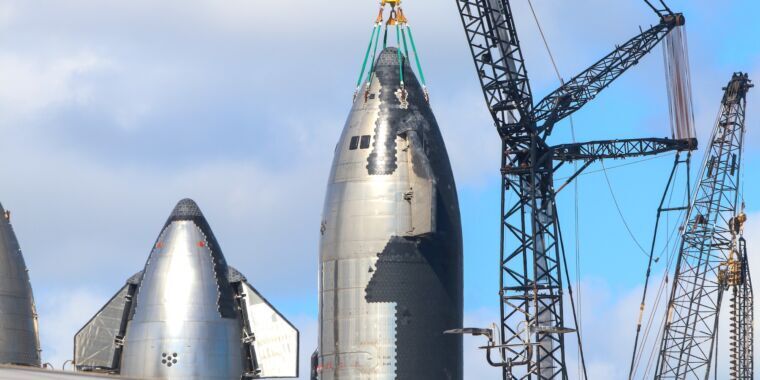- cross-posted to:
- [email protected]
- cross-posted to:
- [email protected]
NASA is keen on demonstrating orbital refueling technology, an advancement that could lead to propellant depots in space to feed rockets heading to distant destinations beyond Earth orbit. In 2020, NASA announced agreements with four companies—Lockheed Martin, United Launch Alliance, SpaceX, and a Florida-based startup named Eta Space—to prove capabilities in the area of refueling and propellant depots using cryogenic propellants.
These cryogenic fluids—liquid hydrogen, methane, and liquid oxygen—must be kept at temperatures of several hundred degrees below zero, or they turn into a gas and boil off. Russian supply freighters regularly refuel the International Space Station with hydrazine and nitrogen tetroxide, room-temperature rocket propellants that can be stored for years in orbit, but rockets using more efficient super-cold propellants have typically needed to complete their missions within hours.
NASA and industry engineers want to extend this lifetime to days, weeks, or months, but this requires new technologies to maintain the propellants at cryogenic temperature and, in some cases like Starship, to transfer the propellants from one vehicle to another.
This test would involve transferring super-cold propellant from one tank to another inside a Starship spacecraft. It’s a precursor to future, more complex demonstrations involving two giant Starships docked together in Earth orbit. Then SpaceX will be ready to send a Starship toward the Moon for a test landing without astronauts onboard. Once that is successful, NASA will clear Starship for a crew landing on the agency’s Artemis III mission, marking the astronauts’ return to the lunar surface for the first time since 1972.
Lakiesha Hawkins, deputy associate administrator for NASA’s Moon to Mars program office, discussed the Artemis schedule Monday with a committee from the National Academies charged with reviewing the agency’s workforce, infrastructure, and technology programs.
Hawkins did not verbally address SpaceX’s plans for the next Starship test flight, but one of her slides noted SpaceX is “moving quickly” toward the third Super Heavy/Starship launch, and that this flight “will include a propellant transfer demonstration.”
However, Jimi Russell, a NASA spokesperson, suggested to Ars this is still only a possibility. When it does happen, the tank-to-tank propellant transfer within Starship will demonstrate moving 10 metric tons of liquid oxygen, according to the 2020 Tipping Point award terms. SpaceX is collaborating with NASA’s Glenn Research Center and Marshall Space Flight Center on the demonstration.



Wait, why would you need to demonstrate this? You can buy any cryogenic pump off the shelf right now, they’re not even expensive. Just pumping cryogenic fluids around is not a challenge, factories and labs do this every day, it’s completely routine. All the hard/complex parts surrounding this are eliminated when you’re simply pumping between two internal tanks.
Edit: the “hard parts” being forming a proper connection between two external ports that can handle cryogenic fuel and storing it long-term in space.
Edit2: I’m assuming it needs to be done in space to qualify. In which case an additional hard part would be getting there, since Starship so far hasn’t managed. Turning on a off-the-shelve magnet-drive pump to move less than 1% of a full fuel load seems kind of an afterthought compared to that.
Try pumping in freefall. All your liquids are just floating around. Not like you can put a spigot on the bottom of the tank. Maybe they will do it under a bit of acceleration, centrifugal force, brooms thingies in the tank? It certainly is quite a challenge but I suspect they got a novel idea.
Isn’t that what ullage engines are for?
Sure, but I imagine you don’t want to have your fuel depot needing to accelerate every time someone wants a top up, kind of makes it hard to keep it in the same orbit.
I’m imagining the way to go would be to evaporate the liquid in the first tank, then pump the gas from one tank to the other one, like you would pump any other gas, and then liquifying that gas to liquid again.
Nothing in space is trivial, even the most simple things like taking a shower, drinking a glass of water or pooping are challenging tasks that requires specialized equipment.
Isn’t there, like, artificial gravity from rotation? I.e. centrifugal forces?
That dosen’t really exist yet.
Fluid handling in free-fall is a nontrivial task. While it’s true that linking tanks in two different vessels is also a technical challenge, there’s plenty of value in demonstrating that you can pump the fluids around at all
I’m guessing it takes some work to harden a cryogenic pump to survive the shock and vibe environments. They would also have to demo their ullage motor setup.